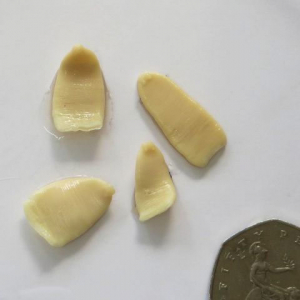Much uncertainty surrounds the significance of tapeworm infections in horses. The natural infection is hard to diagnose in the living animal, and no successful experimental infections have been reported.
The equine tapeworm was considered for many years to be an incidental finding in the intestinal tracts of horses at postmortem examination and rarely associated with clinical disease. Infections usually went undetected because of the difficulties of fecal egg examinations and because no clearly defined clinical symptoms were associated with tapeworms.
Recent studies, however, have defined this parasite as a significant risk factor for spasmodic colic and impactions at the terminal end of the small intestine. Add to this several studies showing tapeworm infection rates as high as 81.5 percent, and an interesting story emerges about a parasite that was previously considered harmless.
Tapeworm Species
Three species of tapeworms are known to infect the horse. Anoplocephala perfoliata, Anoplocephala magna and Paranoplocephala mamillana. Studies have demonstrated A. perfoliata to be the most common tapeworm in the horse. A. magna is the next most common, and P. mamillana is quite rare.
A. perfoliata is a short, yellow/green tapeworm with a triangular body. The size of mature worms varies from three to eight centimeters – tapeworms smaller than this are either immature worms or P. mamillana. The head of A. perfoliata is equipped with four suckers with which the parasite can secure itself to the mucosa of its host. Nutrients are absorbed through the parasite’s cuticle.
Tapeworm Diagnosis
Diagnosing tapeworm infection is difficult. Most infections have no symptoms, but cause subclinical damage that may be present for some time before causing visible disease. One textbook describes unthriftiness and anemia as consequences of heavy infestation, but moderate infections may go unnoticed.
Another factor making diagnosis difficult is the nature of tapeworm eggs. They occur in very small numbers and often in packets rather than individual eggs. They don’t float well in the testing medium, so they are often missed in routine fecal egg-count analysis. More sophisticated tests are needed to visualize tapeworm eggs. Most veterinary practices and labs aren’t equipped to do these tests, so, in many cases, the diagnosis is missed. Sometimes, however, tapeworm specimens can be found in the feces of infected horses after they have been treated with drugs active against these parasites.
The Tapeworm Life Cycle
The tapeworm is different from many other parasites because it has an indirect life cycle. This means it requires an intermediate host in order to develop. The intermediate host of A. perfoliata is the free-living oribatid mite. This mite is found in very large numbers on pastures and often even in hay and straw.
Inside the mite, the tapeworm egg undergoes cellular division and development to become a larva. This process takes 12-15 weeks. Inadvertent ingestion of mites containing infective larvae occurs as horses graze, and it can result in tapeworm infection. Larvae then develop within the primary host – the horse – to mature tapeworms. They can begin shedding segments full of eggs in 6-10 weeks. There appears to be little seasonal variation in the number of horses infected with tapeworms or in the magnitude of infection.
The equine tapeworm usually congregates around the ileocaecal valve in the intestinal tract, at the junction between the large and small intestines. It is in this small area of the horse’s intestinal tract that changes attributable to tapeworms are found. Until recently, few studies had been done of the damage caused by tapeworms.
Tapeworm Damage
The tapeworm can cause severe damage inside the horse’s intestinal tract. Its presence can lead to decreased intestinal motility and colic.
Until the life cycle of A. perfoliata – the common tapeworm – is better understood, it is difficult to decide when to provide horses with appropriate anti-tapeworm drugs. Generally, treatments directed against tapeworms should be given every six months, with treatment in the fall and again in late spring. The role of tapeworms in equine colic should be kept in perspective. They represent a small, but avoidable, risk in certain types of colic.

